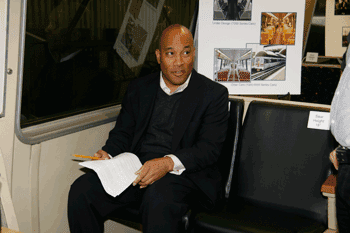 SAN FRANCISCO – BART’s 39-year-old cars are scheduled for an upgrade. Design is underway now, and the transit agency wants your help.
SAN FRANCISCO – BART’s 39-year-old cars are scheduled for an upgrade. Design is underway now, and the transit agency wants your help.
The original cars weren’t intended to last forever, and new cars are an opportunity to advance with the times. BART expects its ridership to increase to 500,000 people per day (up from 335,000 today), and is preparing for its biggest capital investment since opening in 1972. Designing, building, and installing 700 new train cars is expected to cost $3.4 billion.
BART is reaching out to the public to answer the tough questions on the new system, such as:
- Should the seats be smaller? The current 22-inch wide seats are large relative to other systems such as the D.C. Metro (18 inches) or the Los Angeles Metro (17).
- Should the cars have more space for bikes, and if so, how? Currently, 4% of BART riders arrive at the station by bike, and bicycle ridership is expected to continue increasing throughout the Bay Area.
- Should BART keep fabric-covered seats and carpet, or move to other materials that are easier to clean?
- Should each car have more doors?
- What type of passenger information should display inside each car?
- How can BART reconfigure seats to provide more seating?
- Should the cars have power outlets?
Some of these questions are based more on comfort than science, so BART recently unveiled a new “seating lab” with train seats in all different shapes, sizes, spacing, and materials. BART staff began exploring the examples in late January, and the exhibit will open to the public soon.
BART is looking for your feedback on the new car design, and asks anyone that is interested to sign up for news alerts on the new car project. A design will be chosen some time this year, and the first new cars will start showing up in the BART system in 2018.
For more information: BART’s New Car Project
Previously on 511CC: Fleet of the Future
